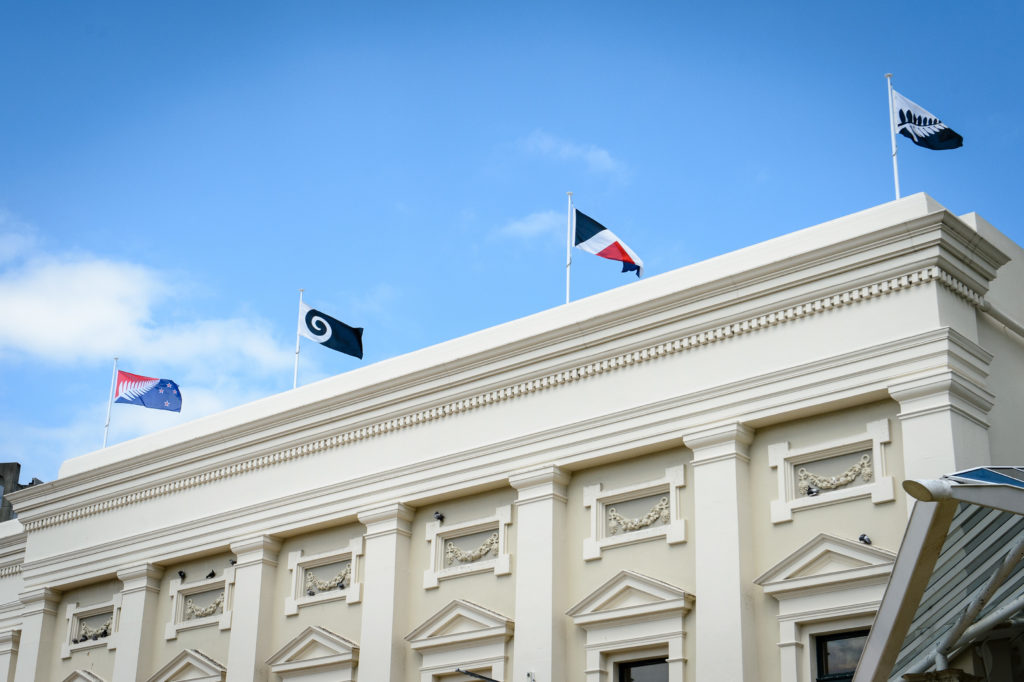Publicist Olivia Lacey talks to Chief Curator Robert Leonard about flying flags over Civic Square.
Olivia Lacey: Our new show, This Is New Zealand, starts outside the gallery. We’re flying six flags in Civic Square, above the Town Hall and the Gallery. There’s the New Zealand flag—designed for use on colonial ships in 1869, and recognised by statute as our national flag in 1902—and the five challengers to it from 2016. Why?
Robert Leonard: Co-curator Aaron Lister and I thought the 2015–6 flag debate offered a great reference point to open our show, which is about national representation. We remembered seeing the five contender flags flying over the Town Hall in 2016. Back then, everyone was talking about the flag, but now it’s yesterday’s news. We thought it would be confusing for people to see the flags restored in Civic Square—as if somehow the debate hadn’t gone away—until they realise they are connected with the show.
Why those flags and not, for example, the Tino Rangatiratanga flag?
Unveiled in 1990, the Tino Rangatiratanga flag represents Māori, but not New Zealand per se. There’s also the United Tribes of New Zealand flag, from 1834, before the Treaty. And, there’s the Friedensreich Hundertwasser flag of 1983. It was intended as a New Zealand flag—a second national flag. So, yes, we could have played the flag idea in different ways. However, as our show spans almost a hundred years, referencing the 2015–6 flag debate was an easy way to tie it to the present and to the real world (not just the art world). Two years ago, for a while, it seemed everyone was arguing about how we could use a rectangle of fabric to represent our entire nation to the world. Together, the six flags draw attention to the arbitrary and conventional nature of representations of identity. New Zealanders could have easily found ourselves rallying behind a silver fern, a koru, or a red triangle.
Was the flag debate political?
It was led by John Key, but it wasn’t necessarily a right-wing cause. There had been earlier calls to change the flag, from right and left. Key picked up a nonpartisan issue, but it became part of his brand and he and his cause suffered as a consequence.
Over the decades, the arguments for changing the flag have been consistent: our current flag is too like Australia’s and the colonial implication of the Union Jack is a turn-off. A new flag is a good idea. But, in 2015–6, the process became a problem. I think it was a mistake to make the flag design itself such a public thing, because that made it divisive. People wouldn’t identify with a flag they didn’t vote for. Plus, everyone started having way too much fun with the idea—at the expense of the bigger question. Over 10,000 flag designs were submitted. Many were just variants on existing, predictable ideas: the silver fern, the koru, the kiwi, sheep, the Southern Cross, and the long white cloud. Default ideas. Clichés. Then people got more excited and distracted by silly designs that would never fly.
What were some of the silly ones?
‘Fire the Lazar!’, the alt-right ‘Te Pepe’, ‘Sheep and Hokey Pokey’, the brilliantly abstracted ‘Flat White with Saucer’, and ‘Eggsplosion’—whose justification was ‘because New Zealanders like eggs and explosions are cool’.
There are other flags in This Is New Zealand.
The Treaty is signed on a Union Jack tablecloth in Marcus King’s famous 1938 painting. The flags of the members of the Five Eyes intelligence alliance—New Zealand, the US, the UK, Australia, and Canada—hang limp in Simon Denny’s 2015 Venice Biennale work. Bronwyn Holloway-Smith’s room is painted blue to recall the blue of the flag. And the flag is co-opted in TV ads for the National Party and the Bank of New Zealand. But, despite all this, I don’t think New Zealanders are flag wavers, unlike Americans, who pledge allegiance to the flag and whose national anthem is addressed to the flag. Perhaps, in the end, that’s why the flag debate foundered. Not many people care deeply about the flag, and there’s little motivation to change it into something they would care deeply about.



